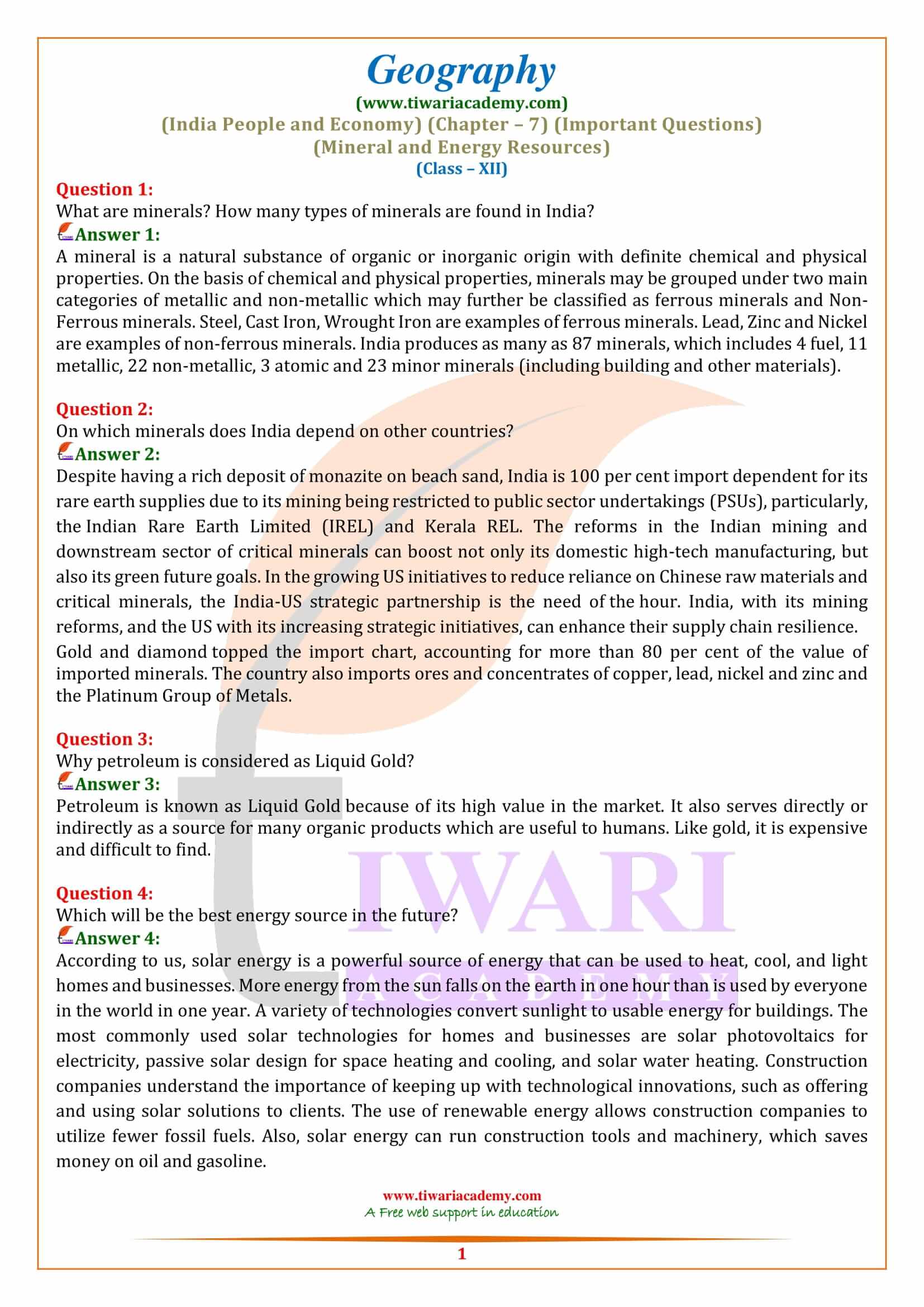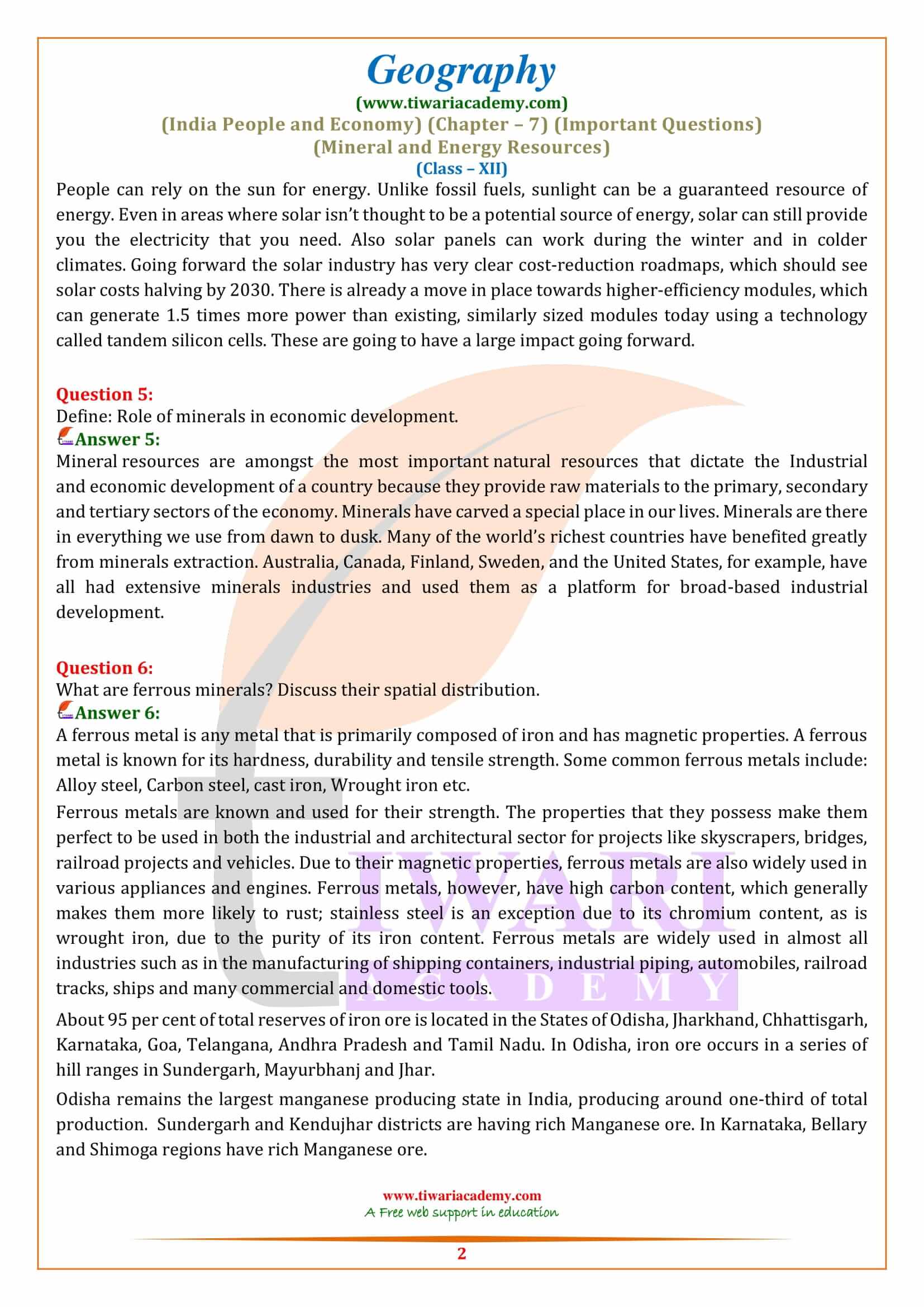Class 12 Geography Part 2 Chapter 7 Important Questions of Mineral and Energy Resources prepared for CBSE as well as State board students in accordance with 2024-25 curriculum. Class 12 Geography chapter 7 extra questions of India People and Economy are given here as easy and important questions.
Class 12 Geography Chapter 7 Important Questions
Class 12 Geography Chapter 7 Important Extra Question Answers
What are minerals? How many types of minerals are found in India?
A mineral is a natural substance of organic or inorganic origin with definite chemical and physical properties. On the basis of chemical and physical properties, minerals may be grouped under two main categories of metallic and non-metallic which may further be classified as ferrous minerals and Non-Ferrous minerals. Steel, Cast Iron, Wrought Iron are examples of ferrous minerals. Lead, Zinc and Nickel are examples of non-ferrous minerals. India produces as many as 87 minerals, which includes 4 fuel, 11 metallic, 22 non-metallic, 3 atomic and 23 minor minerals (including building and other materials).
Why petroleum is considered as Liquid Gold?
Petroleum is known as Liquid Gold because of its high value in the market. It also serves directly or indirectly as a source for many organic products which are useful to humans. Like gold, it is expensive and difficult to find.
On which minerals does India depend on other countries?
Despite having a rich deposit of monazite on beach sand, India is 100 per cent import dependent for its rare earth supplies due to its mining being restricted to public sector undertakings (PSUs), particularly, the Indian Rare Earth Limited (IREL) and Kerala REL. The reforms in the Indian mining and downstream sector of critical minerals can boost not only its domestic high-tech manufacturing, but also its green future goals.
In the growing US initiatives to reduce reliance on Chinese raw materials and critical minerals, the India-US strategic partnership is the need of the hour. India, with its mining reforms, and the US with its increasing strategic initiatives, can enhance their supply chain resilience.
Gold and diamond topped the import chart, accounting for more than 80 per cent of the value of imported minerals. The country also imports ores and concentrates of copper, lead, nickel and zinc and the Platinum Group of Metals.
Which will be the best energy source in the future?
According to us, solar energy is a powerful source of energy that can be used to heat, cool, and light homes and businesses. More energy from the sun falls on the earth in one hour than is used by everyone in the world in one year. A variety of technologies convert sunlight to usable energy for buildings. The most commonly used solar technologies for homes and businesses are solar photovoltaics for electricity, passive solar design for space heating and cooling, and solar water heating.
Construction companies understand the importance of keeping up with technological innovations, such as offering and using solar solutions to clients. The use of renewable energy allows construction companies to utilize fewer fossil fuels. Also, solar energy can run construction tools and machinery, which saves money on oil and gasoline.
People can rely on the sun for energy. Unlike fossil fuels, sunlight can be a guaranteed resource of energy. Even in areas where solar isn’t thought to be a potential source of energy, solar can still provide you the electricity that you need. Also solar panels can work during the winter and in colder climates. Going forward the solar industry has very clear cost-reduction roadmaps, which should see solar costs halving by 2030. There is already a move in place towards higher-efficiency modules, which can generate 1.5 times more power than existing, similarly sized modules today using a technology called tandem silicon cells. These are going to have a large impact going forward.
What are ferrous minerals? Discuss their spatial distribution.
A ferrous metal is any metal that is primarily composed of iron and has magnetic properties. A ferrous metal is known for its hardness, durability and tensile strength. Some common ferrous metals include: Alloy steel, Carbon steel, cast iron, Wrought iron etc.
Ferrous metals are known and used for their strength. The properties that they possess make them perfect to be used in both the industrial and architectural sector for projects like skyscrapers, bridges, railroad projects and vehicles. Due to their magnetic properties, ferrous metals are also widely used in various appliances and engines. Ferrous metals, however, have high carbon content, which generally makes them more likely to rust; stainless steel is an exception due to its chromium content, as is wrought iron, due to the purity of its iron content. Ferrous metals are widely used in almost all industries such as in the manufacturing of shipping containers, industrial piping, automobiles, railroad tracks, ships and many commercial and domestic tools.
About 95 per cent of total reserves of iron ore is located in the States of Odisha, Jharkhand, Chhattisgarh, Karnataka, Goa, Telangana, Andhra Pradesh and Tamil Nadu. In Odisha, iron ore occurs in a series of hill ranges in Sundergarh, Mayurbhanj and Jhar.







